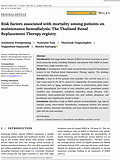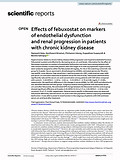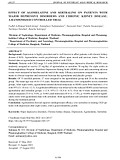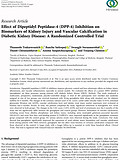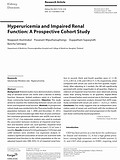PUBLICATION

2025
Background:
Chronic kidney disease (CKD) represents a worldwide health problem because studies suggest its prevalence reaches 8–16%. In Thailand, it is a significant public health issue. The Thai Society of Nephrology conducted the Screening and Early Evaluation of Kidney Disease (SEEK) study from 2007 to 2008 which demonstrated that the prevalence of CKD was 17.5%1. One of the key...
Introduction:
Dialysis care in Asia is influenced by government support, patient-centered policies, and efforts to improve access to quality kidney care services. Despite progress disparities remain between affluent nations and lower-income countries,...
Introduction:
The incidence of treated end-stage kidney disease (ESKD) has remained stable in many high-income countries but has risen significantly in East and Southeast Asia.1 This global increase is attributed to factors such as improved survival rates...
Background:
Leucine, a branched-chain amino acid (BCAA), is an effective nutritional strategy to enhance skeletal muscle mass in aging populations. This study aimed to evaluate the effects of oral leucine-enriched BCAA supplementation on muscle mass, muscle synthesis biomarkers, and physical performance...
Objective:
The prevalence of chronic kidney disease (CKD) in Thailand is high and kidney disease progression
remains a problem. Empagliflozin has been known to be used to slow CKD progression, but
its accessibility remains limited. This study aimed to assess the cost-utility of empagliflozin for CKD
progression in Thailand...
Introduction:
Despite optimization of renin-angiotensinaldosterone system (RAAS) inhibition, patients with IgA nephropathy remain at risk for kidney failure. The effect of steroids on kidney outcomes in IgA nephropathy with different renal pathologic lesions has been uncertain...
Introduction:
Treating lupus nephritis is vital to reducing morbidity and mortality. In Thailand, comparative data on
intravenous cyclophosphamide- and mycophenolate mofetil (MMF)-based induction therapies are limited. This study assessed renal remission outcomes for these regimens....
บทคัดย่อ:
โรคไตจากเบาหวานเป็นสาเหตุสำคัญของไตเรื้อรังระยะสุดท้าย ในอดีตโรคไตจากเบาหวานมีระยะการดำเนินโรคสัมพันธ์กับการมีอัลบูมินรั่วในปัสสาวะ ตามมาด้วยการทำงานของไตที่ลดลงจนเข้าสู่โรคไตเรื้อรังระยะสุดท้าย การรักษาในปัจจุบันมุ่งเน้นในการชะลอความเสื่อมของไตผ่านทางการลดอัลบูมินในปัสสาวะ...
2024
Introduction:
End-stage kidney disease (ESKD) has been increasing in prevalence across the world, including Thailand, and patients with ESKD on hemodialysis have a high mortality risk...
Oral nutritional supplementation (ONS) is recommended for malnourished hemodialysis patients
when their nutritional intake remains inadequate to meet energy and protein requirements. Patients
were randomized into two groups: the intradialytic ONS supplements (INTRA-ONS) group (N = 16)
and the interdialytic ONS supplements (INTER-ONS) group (N = 16) for a duration of 12 weeks.
Malnutrition inflammation score (MIS) and serum albumin levels...
Introduction:
Chronic kidney disease (CKD) with a global prevalence of 13.4%, is a major contributor to morbidity and mortality due to noncommunicable diseases [1]. It is the 12th leading cause of death worldwide and is projected to be the 5th leading cause of death by 2040...
Abstract:
Resistant hypertension (RH) includes hypertensive patients with uncontrolled blood pressure (BP) while receiving ≥3 BP-lowering medications or with controlled BP while receiving ≥4 BP-lowering medications. The exact prevalence of RH is challenging to...
2023
Hyperuricemia relates to chronic kidney disease (CKD) progression and impaired endothelial function.
Febuxostat is potent and effective for decreasing serum uric acid levels. Information for the effect of
febuxostat treatment on markers of endothelial dysfunction and renal injury among patients with
CKD remains limited. A total of 84 patients with...
ฺBackground:
Sarcopenia is a progressive muscle disease in three modalities: loss of muscle mass, muscle strength, and decreased performance status. Sarcopenia has a high incidence in hemodialysis patients 30%–70% and 25%–45% in peritoneal dialysis patients...
Objective:
AURORA 2 evaluated the long-term safety, tolerability, and efficacy of voclosporin compared to placebo in patients with lupus nephritis (LN) receiving an additional two years of treatment following completion of the one-year AURORA 1 study...
Objective:
To characterize its dose-response relationship, BI 655064 (an anti-CD40 monoclonal antibody) was
tested as an add-on to mycophenolate and glucocorticoids in patients with active lupus nephritis (LN)...
2022
ABSTRACT:
Background: Decline of estimated glomerular filtration rate (eGFR) is associated with increased cardiovascular (CV) morbidity and mortality, but the predictive value of different eGFR on CV outcomes is limited in Southeast Asian populations. Aims We aimed to stratify CV outcomes according to renal function among Thai patients with high atherosclerosis risk....
ABSTRACT:
Background: Depression is highly prevalent and is well known to affect patients with chronic kidney
disease (CKD). Agomelatine exerts psychotropic effects upon mood and anxious states. There is
limited data on agomelatine treatment among patients with CKD...
PURPOSE:
Nephrotoxicity is a major dose-limiting toxicity among patients with cancer who were treated with
cisplatin. Although no standard approach is available to prevent cisplatin-induced nephrotoxicity, administering intravenous isotonic saline is recommended...
ABSTRACT:
Aim Elevated fibroblast growth factor-23 (FGF23) is an established marker of cardiovascular disease among patients with type 2 diabetes (T2DM) and chronic kidney disease (CKD). Recently, circulating FGF23 positively correlated with insulin resistance level among patients with CKD.
2021
Background:
The advantage of dipeptidyl peptidase-4 (DPP-4) inhibitors is their lower risk of inducing hypoglycemia among patients with type 2 diabetes [1]. DPP-4 inhibitors impede the proteolytic enzyme DPP-4, resulting in delayed degradation of glucagon-like peptide I (GLP-1), thus improving glycemic control. Additionally, GLP-1 regulates the calcification of vascular smooth muscle cells through numerous pathways...
Background:
There is increasing awareness of the impact of obesity and underweight on cardiovascular (CV) disease, chronic kidney disease (CKD) and mortality. Abnormal body mass index (BMI) might be associated with worse clinical outcomes, including CKD progression, but limited evidence exists among Asian patients with high CV risk...
Background:
Constipation is a common problem among patients with advanced chronic kidney disease (CKD), leading to a loss of life. Pharmacologic treatments are in common use, but whether lactulose and senna plus ispaghula husk is effecive to treat constipation among patients with pre-dialysis CKD...
Background:
Vitamin D deficiency is a common problem among patients on continuous ambulatory peritoneal dialysis (CAPD). Vitamin D supplementation leads to reduced serum parathyroid hormone levels and improved cardiovascular markers. Different doses and time intervals of oral vitamin D supplementation may differ in each patient on dialysis. ,e study aimed to evaluate the efficacy of weekly split and single dose of ergocalciferol at 60,000 IU....
ABSTRACT:
Background A precise description of renal histological lesions and an appropriate classification of lupus nephritis are both essential for nephrologists to guide treatment and predict prognosis among patients. The prognostic value of ISN/RPS 2003 classification is controversial....
ABSTRACT:
Long-term dialysis involves a chronic inflammatory state and produces a high prevalence of vitamin D deficiency. A clinical trial was conducted in hemodialysis with serum 25-hydroxyvitamin D (25[OH]D) level <30 ng/ml. The conventional-group (N = 35) and...
ABSTRACT:
Background Malnutrition is highly prevalent and a consequence of inflammation and related comorbidities among patients on maintenance hemodialysis. Oral nutritional supplementation (ONS) is recommended ...
Urine albumin dipstick independently predicts cardiovascular and renal outcomes among rural Thai population: a 14-year retrospective cohort study
ABSTRACT:
Background: Albuminuria is an established risk marker for both cardiovascular and renal outcomes. In this study, we expected to use portable and inexpensive test strips to detect urine albumin level..
2020
ABSTRACT:
Background: Related studies have demonstrated a relationship of elevated serum uric levels with a decline in kidney function. However, limited evidence exists in a Southeast Asian community-based population....
ABSTRACT:
Background: Hyponatremia is one of the most common electrolyte abnormalities in hospitals. Treatment of hyponatremia depends on symptoms and etiology related to volume status of the patients. Sometime evaluating volume status of patients...
Rate of kidney function decline and factors predicting progression of kidney disease in type 2 diabetes mellitus patients with reduced kidney function: A nationwide
retrospective cohort study
ABSTRACT: Currently, the data on independent risk factors for the progression of kidney disease
in type 2 diabetes mellitus (T2DM) patients with CKD are...
Real- world Evaluation of glycemic control and hypoglycemic Events among
type 2 Diabetes mellitus study (REEDS): a multicentre, cross- sectional study
in Thailand
ABSTRACT: Objective Patients with type 2 diabetes mellitus (T2DM) often experience hypoglycaemia and weight gain due to treatment side effects. Sulfonylureas (SU) and...
Impaired Glomerular Filtration Rate in Type 2 Diabetes Mellitus Subjects:
A Nationwide Cross-Sectional Study in Thailand
Abstract:
Background and Objective: Low nutritional intake is common in advanced chronic kidney disease
(CKD) and poses a direct risk for...
EFFECT OF RENAL SPECIFIC ORAL NUTRITION (ONCE RENAL) ON DIETARY INTAKE AND SERUM ELECTROLYTES IN CHRONIC KIDNEY DISEASE STAGE IV
Abstract:
Background and Objective: Low nutritional intake is common in advanced chronic kidney disease
(CKD) and poses a direct risk for...
Abstract: Patients with chronic kidney disease (CKD) have a higher risk of mortality, mostly from cardiovascular complications. Currently, the biomarkers...
Arterial Stiffness Predicts Rapid Decline in Glomerular Filtration Rate Among Patients with High Cardiovascular Risks
Aims: Arterial stiffness is known to be an important surrogate marker for atherosclerosis and predictor of peripheral vascular and cardiovascular (CV) disease. Whether high...
Background. Glycosaminoglycan plays an important role in the maintenance of glomerular charge selectivity of diabetic nephropathy. Sulodexide, a mixture of naturally occurring...
2019
Urinary biomarkers of tubular injury to predict renal progression and end stage renal disease in type 2 diabetes mellitus with advanced nephropathy: A prospective cohort study
Background: Novel potential tubular biomarkers in diabetic nephropathy could improve risk stratification and
prediction...
Role of TCF7L2 and PPARG2 Gene Polymorphisms in Renal and Cardiovascular Complications among Patients with Type 2 Diabetes: A Cohort Study
Background: The emerging renal and cardiovascular complications of type 2 diabetes (T2DM) genetics involves differently assembled gene variants including transcription factor 7-like 2 (TCF7L2)...
2018

Background: A very low protein diet (VLPD) with ketoacid analogs of essential amino acids (KA/EAA) administration
can remarkably influence protein synthesis and metabolic...

Background. Intensive glucose control reduces the risk for microvascular complications in type 2 diabetes (T2DM). Recently, sodium-glucose cotransporter 2 (SGLT2) inhibitors have been shown to exert renoprotection...

Background: Choices of hypoglycemic agents for patients with type 2 diabetes and chronic kidney disease (CKD) are limited. Available data among patients with CKD suggest that...

Background: Increased monocyte chemoattractant protein-1 (MCP-1) and decreased epidermal growth factor (EGF)...

OBJECTIVE: Systolic hypertension is common in elderly patients and remains a challenge to treat effectively...

Patients with diabetic nephropathy have a higher risk of mortality, mostly from cardiovascular complications. Standard biomarkers including serum creatinine, estimated glomerular filtration rate, and albuminuria are imprecise, do not directly measure renal tissue injury...
2017

Background: Tubulointerstitial injury is important to predict the progression of lupus nephritis (LN). Urine neutrophil
gelatinase-associated lipocalin (NGAL)...

Background: Diabetes is the leading cause of end-stage renal disease (ESRD) and accounts for 40–50% of patients requiring renal replacement therapy...

Background: Malnutrition is an important problem in patients treated with long-term dialysis, and most dialysis patients have lower dietary energy...

โรคไตอักเสบลูปัส Lupus Nephritis เป็นสาเหตุสำคัญของการเพิ่มอัตราการเจ็บป่วย และการเสียชีวิตในผู้ป่วย systemic lupus erythematosus (SLE)...

Background: Anemia associated with chronic kidney disease (CKD) often requires treatment with recombinant human erythropoietin (EPO)...
2016

Background. Tubulointerstitial injury is both a key feature of diabetic nephropathy and an important predictor of renal dysfunction. Novel tubular biomarkers related to renal injury in diabetic nephropathy could improve risk stratification and prediction...

Abstract: Periostin is a novel biomarker related to kidney disease progression. The aim of this study was to examine the
level of periostin staining within renal tissue from IgA nephropathy patients...

Background: Malnutrition is one common adverse consequence in patients with advanced chronic kidney disease (CKD), and most patients have a lower-than-normal dietary energy intake...

Background: The use of selective COX-2 (sCOX-2) inhibitors with acute kidney injury, salt water retention, and cardiovascular events have been correlated in subjects with normal kidney function...

Background: Exertional heat stroke (EHS) is a life-threatening illness and leads to multi-organ dysfunction including
acute kidney injury (AKI). The clinical significance of abnormal electrolytes and renal outcomes in ESH patients has
been poorly documented...
2015

Background: Vitamin D deficiency/insufficiency is common in chronic kidney disease (CKD) patients and it contributes to
secondary hyperparathyroidism...

Glycosaminoglycans or sulodexide has shown benefits in early experimental diabetic nephropathy (DN) models, but its efficacy in patients with early stage of DN is unknown. Methods...

Current data suggests that statins might have beneficial effects on renal outcomes. Beneficial effects of statin treatment on renal progression in advanced chronic kidney disease (CKD) are obviously controversial...

Background: Diabetic nephropathy (DN) often results in end-stage renal disease, and this is the most common reason
for initiation of dialysis in the United States. Complications of diabetes...

Background: Improving the early detection of diabetic nephropathy remains a great challenge in disease management. Periostin is a marker of renal tubular injury and related to progressive kidney injury in animal models of chronic kidney disease. The clinical implications of urinary periostin activities in patients with type 2 diabetes have not been evaluated...

Background: Many renal transplant recipients develop complications such as obesity, posttransplantation diabetes mellitus, and dyslipidemia. There have been few studies of metabolic syndrome (MS) in Asian renal transplant recipients...

Lupus nephritis (LN) is one of the most serious complications in patients with systemic lupus erythematosus (SLE). At present, there is no specific biomarker with high sensitivity and renal pathology involvement in use in clinical practice...

Clinicopathological Correlation in Asian Patients with Biopsy-Proven Lupus Nephritis
A total of 244 patients with lupus nephritis (219 women (89.8%) with a female to male ratio of 9 : 1) were included in the study. Clinical and laboratory findings at renal biopsy are clinically valuable in identifying different renal classifications of lupus pathology...

Performance of the estimated glomerular filtration rate creatinine and cystatin C based equations in Thai patients with chronic glomerulonephritis
Background: Glomerular filtration rate (GFR) is considered the indicator of overall kidney function, and therefore, its assessment has become an important clinical tool in the daily care of chronic glomerulonephritis (CGN) patients. Currently, practical guidelines recommend using Chronic Kidney Disease Epidemiology Collaboration (CKD-EPI) equations to assess GFR in CKD patients...

Background: Hyperuricemia has been associated with increased risk of endothelial dysfunction, cardiovascular, and renal
disease. Allopurinol is a potent xanthine oxidase inhibitor used in hyperuricemic patients. It has been shown to decrease
cardiovascular disease and hypertension. However, studies have reported conflicting evidence on its effects on blood pressure
(BP) and estimated glomerular filtration rate (GFR) in chronic kidney disease (CKD) patients...
2014

Background: Chronic allograft nephropathy (CAN) represents the main cause of renal allograft failure after transplantation. Noninvasive CAN testing is required. Periostin promotes the expression of a mesenchymal phenotype in renal tubules and is a promising urine biomarker for progressive renal injury. Information regarding periostin expression in
the setting of CAN remains scarce...

บทนำ: โรคไตอักเสบ glomerulonephritis เป็นการบาดเจ็บของไตแบบรุนแรง และพบได้บ่อย peirostin เป็นโปรตีนชนิดหนึ่งที่
มีบทบาทในขบวนการซ่อมแซมของเนื้อเยื่อต่างๆ และ peirostin มีระดับเพิ่มขึ้นในภาวะไตวาย แต่ข้อมูลของการแสดงออกของ
periostin ในโรคไตอักเสบมีจำนวนจำกัด...

A Comparative Study of Efficacy and Safety of the Lyophilized Powder Alpha-Erythropoietin and the Liquid Form Alpha-Erythropoietin for Hemoglobin Maintenance in Patients with Hemodialysis Treatment
Background: Insufficient production of erythropoietin (EPO) is the primary cause of anemia in patients with chronic kidney
disease (CKD). The EPO treatment is an established treatment for renal anemia. The study investigated the therapeutic
outcome between lyophilized powder and liquid form of EPO alpha by intravenous (IV) administration in hemoglobin
maintenance of anemic treatment for CKD patients receiving hemodialysis...

Abstract: Diabetic nephropathy(DN)isaleadingcauseofmortalityandmorbidityinpatients
with diabetes.Thiscomplicationreflects acomplexpathophysiology,whereby
variousgeneticandenvironmentalfactorsdeterminesusceptibilityandprogression
to end-stagerenaldisease...

Background. Activation of the renin–angiotensin–aldosterone system (RAAS) is an important mediator
of diabetic nephropathy. Urinary angiotensinogen, a novel biomarker of the intrarenal RAAS, is
associated with progressive kidney injury. In this study, the authors investigated the determinants
of urinary angiotensinogen and its associations with staging of diabetic nephropathy.
2013

Background: Vitamin D insufficiency is associated with proteinuria and could be a risk factor for end-stage renal
disease (ESRD). However, few studies have examined the significance of vitamin D insufficiency as a contributing
factor for the development of ESRD in the Asian chronic kidney disease (CKD) population...

Background: Vitamin D insufficiency is associated with proteinuria and could be a risk factor for end-stage renal
disease (ESRD). However, few studies have examined the significance of vitamin D insufficiency as a contributing
factor for the development of ESRD in the Asian chronic kidney disease (CKD) population....

Background: Apolipoprotein E (ApoE) polymorphisms have been proposed as the risk factor for the development of diabetic nephropathy (DN). A number of studies have investigated the association between the ApoE isoforms and DN. However, the findings remain inconclusive...
2012

Background and objectives Sarcopenia is common in hemodialysis patients. This study examined whether the
anabolic steroid oxymetholone improves muscle mass and handgrip strength in hemodialysis patients and
possible mechanisms that might engender such changes...

Background/Aims: Chronic kidney disease involves inflammation/
oxidative stress, which contributes to progressive
kidney injury...
2011

Background. Periostin acts as an adhesion molecule
during bone formation. Knowledge of its expression in
kidney injury is scant...










